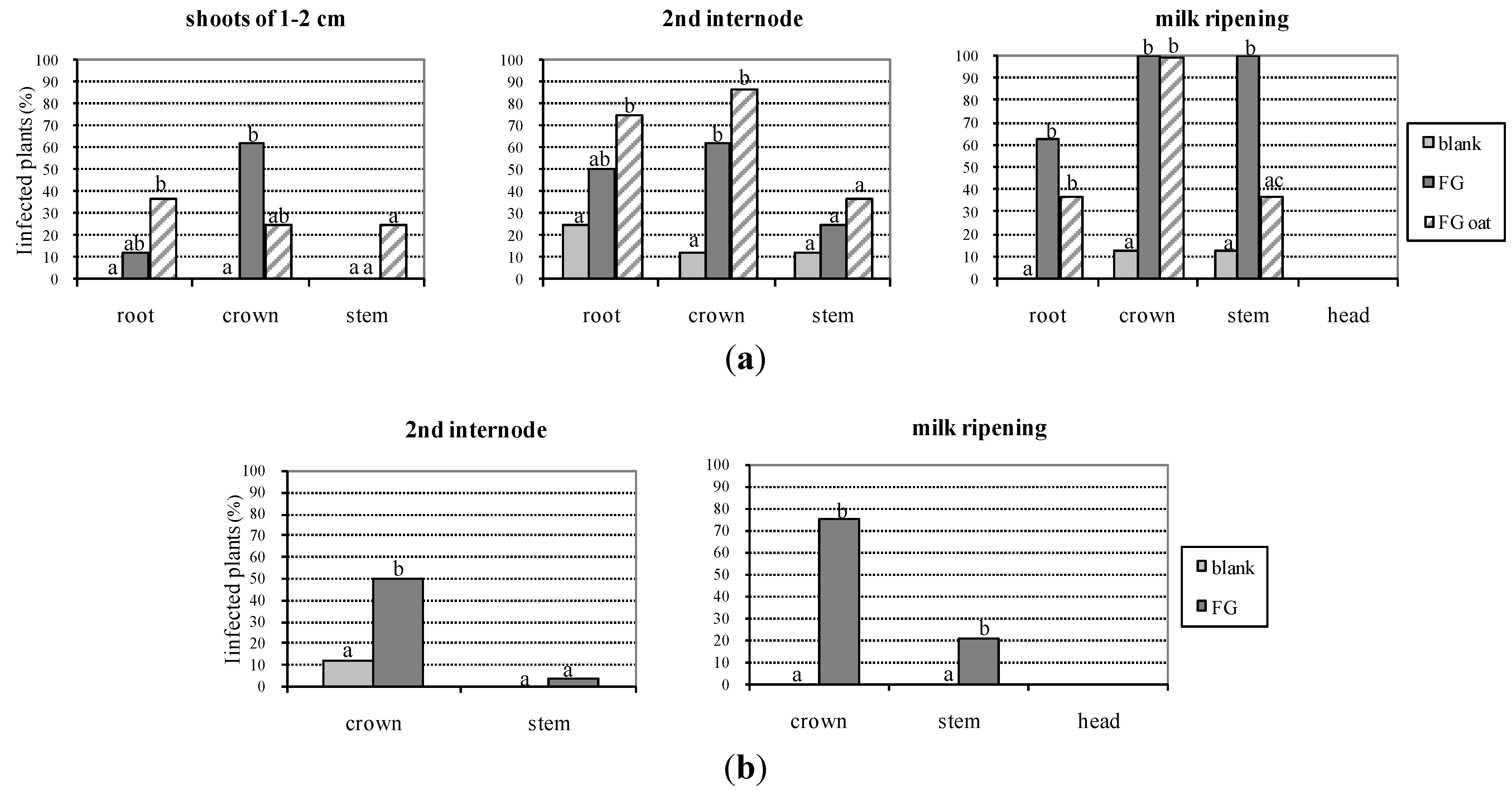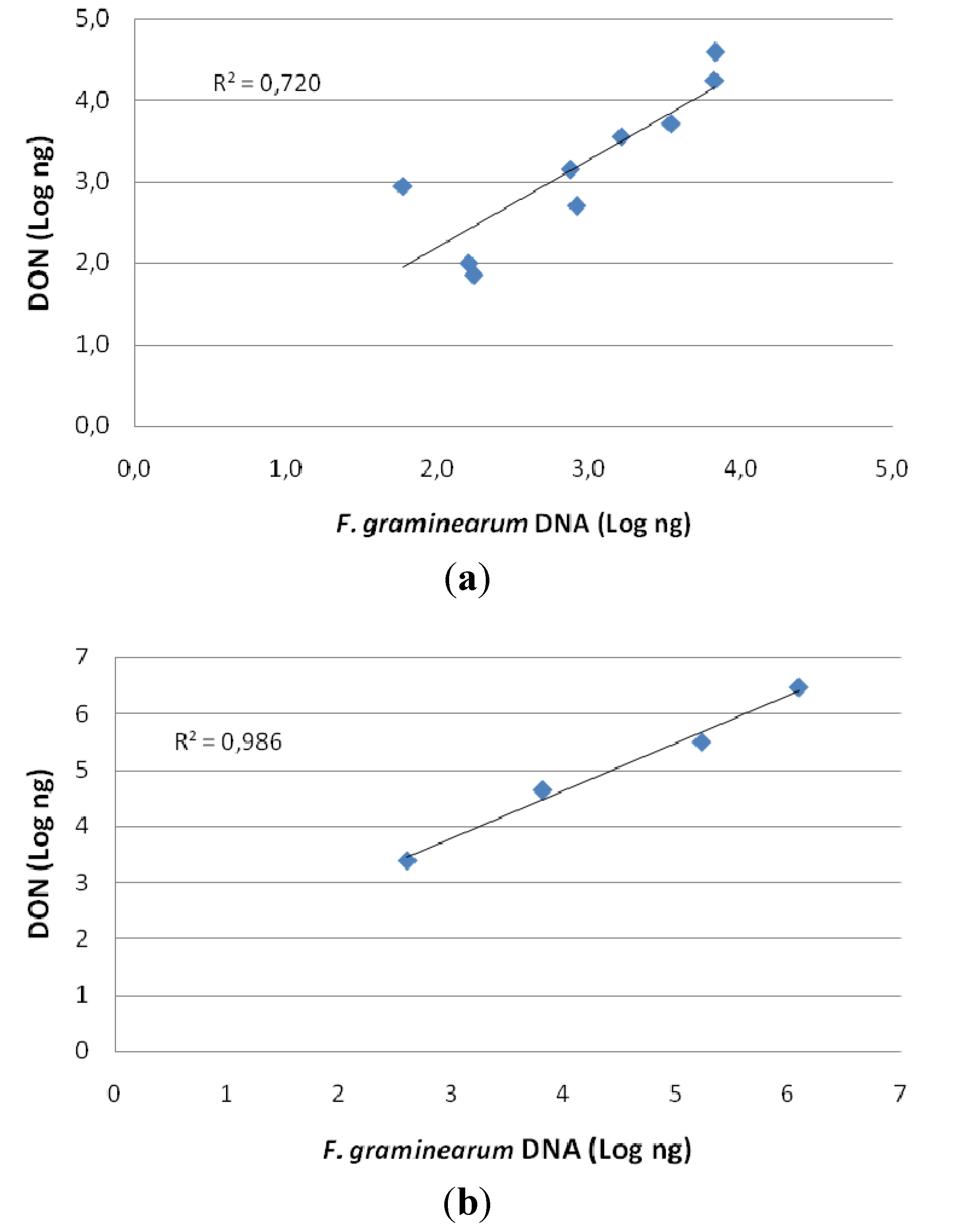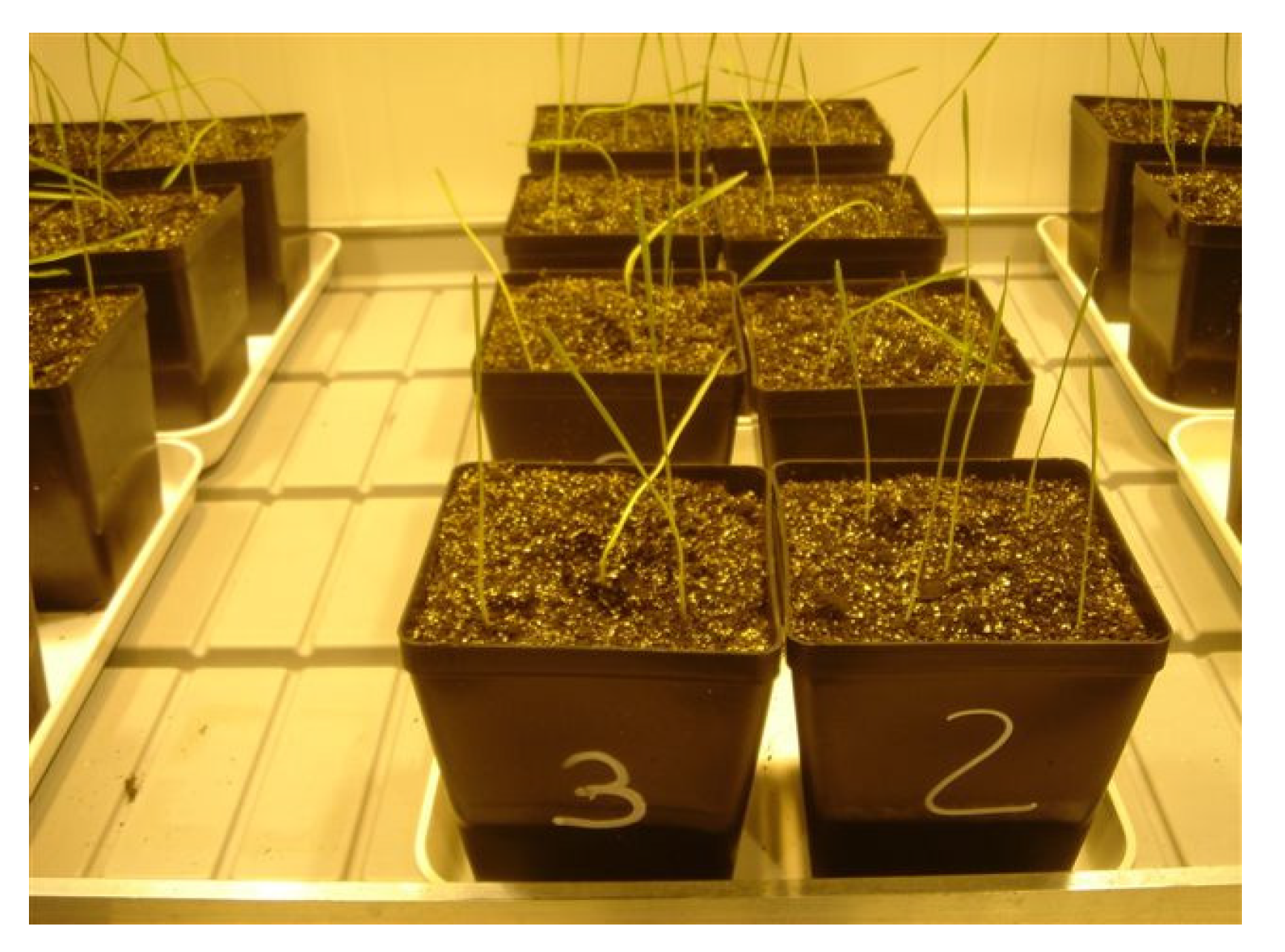Systemic Growth of F. graminearum in Wheat Plants and Related Accumulation of Deoxynivalenol
Abstract
:1. Introduction
- to evaluate the possibility of seed transmission of F. graminearum to the whole wheat plants;
- to evaluate the DON content in the heads due to its production by F. graminearum strains occurring in seeds;
- to evaluate the amount of possible DON-3G occurring in planta due to this type of colonization by F. graminearum.
2. Results and Discussion
2.1. Fusarium and DON Contamination of Kernels Used for the Experiments and DON Production by Strain ITEM 126
2.2. Detection of F. graminearum in the Wheat Plants

2.3. Qualitative PCR
2.4. Vegetative Compatibility Group
2.5. Quantitative PCR

2.6. Chemical Analysis of DON and DON-3G
| Stage of growth | Part of plant | Blank | FG | FG oat |
|---|---|---|---|---|
| Shoots of 1–2 cm | Crown + Stem | Nd | 0.3 | 0.2 |
| second internode | Crown + Stem | 2.3 | 2.0 | 0.8 |
| Milky ripening | Crown + Stem | 0.2 | 14.6 | 27.0 |
| Heads | Nd | 0.9 | 0.3 | |
| Vitreous ripening | Kernels | Nd | 0.1 | 0.2 |
| Stage of growth | Part of plant | Blank | F. graminearum | ||
|---|---|---|---|---|---|
| DON | DON-3G | DON | DON-3G | ||
| second internode | Crown | Nd | - | 21.6 | - |
| Stem | Nd | - | 4.6 | - | |
| Milky ripening | Crown | Nd | - | 87.5 | 27.3 |
| Stem | Nd | - | 10.3 | 5.5 | |
| Heads | Nd | - | 0.1 | 2.3 | |
| Vitreous ripening | Straw | Nd | - | 23.8a | 16.8b |
| Kernels | Nd | - | 0.1a | 0.1a | |
2.7. Relationship between Fungal and DON Contamination

2.8. Discussion
3. Experimental Section
3.1. Plant Material
3.2. Experimental Trial for Fungal Inoculation


3.3. Growth Chamber
3.4. Mycological Investigation by Microscopical and Molecular Analyses
3.5. Statistical Analyses
4. Conclusions
- -
- Fusarium graminearum can grown systemically in the plant tissues from the seeds. However, there is a barrier at the head level for the fungus that gets the heads free from the fungus;
- -
- the level of contamination in planta of both F. graminearum and DON has been shown extremely high;
- -
- low levels of DON and DON-3G, equivalent to 0.2% of total DON produced by F. graminearum in the plant, were found in the kernels that resulted free of F. graminearum;
- -
- DON and DON-3G can be moved from lower parts of the plants to the heads probably due to their water solubility;
- -
- DON is largely glycosylated to DON-3G by the whole wheat plant at different growth stages, leading to a high DON-3G accumulation in different parts of plants;
- -
- a good correlation index between the DNA of F. graminearum detected in the samples by quantitative PCR and DON content has been obtained;
- -
- the high level of DON occurring in the straw, detected in this study, is extremely worrisome since straw is used for bedding and this is consumed by livestock and therefore is an additional source of mycotoxin.
Acknowledgments
Authors Contributions
Conflicts of interest
References
- Bottalico, A.; Perrone, G. Toxigenic Fusarium species and mycotoxins associated with head blight in small-grain cereals in Europe. Eur. J. Plant Pathol. 2002, 108, 611–624. [Google Scholar] [CrossRef]
- Xu, X.-M.; Nicholson, P. Community ecology of fungal pathogens causing wheat head blight. Annu. Rev. Phytopathol. 2009, 47, 83–103. [Google Scholar] [CrossRef]
- Desjardins, A.E. Fusarium Mycotoxins: Chemistry, Genetics and Biology; American Phytopathological Society Press: St. Paul, MN, USA, 2006. [Google Scholar]
- European Commission. Commission Regulation EC No. 1126/2007 of 28 September 2007 amending Regulation EC No. 1881/2006 setting maximum levels for certain contaminants in foodstuffs as regards Fusarium toxins in maize and maize products. Off. J. Eur. Union 2007, 255, 14–17. [Google Scholar]
- Berthiller, F.; Dall’Asta, C.; Corradini, R.; Marchelli, R.; Sulyok, M.; Krska, R.; Adam, G.; Schuhmacher, R. Occurrence of deoxynivalenol and its 3-beta-d-glucoside in wheat and maize. Food Addit. Contam. Part A Chem. Anal. Control Expo. Risk Assess. 2009, 26, 507–511. [Google Scholar] [CrossRef]
- Boshoff, W.H.P.; Pretorius, Z.A.; Swart, W.J. Fusarium species in wheat grown from head blight infected seed. S. Afr. Tydskr. Plant Grond 1998, 15, 46–47. [Google Scholar]
- Mudge, A.M.; Dill-Macky, R.; Dong, Y.; Gardiner, D.M.; White, R.G.; Manners, J.M. A role for the mycotoxin deoxynivalenol in stem colonisation during crown rot disease of wheat caused by Fusarium graminearum and Fusarium pseudograminearum. Physiol. Mol. Plant Pathol. 2006, 69, 73–85. [Google Scholar] [CrossRef]
- Poels, P.; Sztor, E.; Cannaert, F. Fusariose elle peut migrer de la semence à l’épi. Phytoma 2006, 593, 9–12. [Google Scholar]
- Duthie, J.A.; Hall, R. Transmission of Fusarium graminearum from seed to stems of winter wheat. Plant Pathol. 1987, 36, 33–37. [Google Scholar] [CrossRef]
- Clement, J.A.; Parry, D.W. Stem-base disease and fungal colonisation of winter wheat grown in compost inoculated with Fusarium culmorum, F. graminearum and Microdochium nivale. Eur. J. Plant Pathol. 1998, 104, 323–330. [Google Scholar] [CrossRef]
- Covarelli, L.; Beccari, G.; Steed, A.; Nicholson, P. Colonization of soft wheat following infection of the stem base by Fusarium culmorum and translocation of deoxynivalenol to the head. Plant Pathol. 2012, 61, 1121–1129. [Google Scholar] [CrossRef]
- Beccari, G.; Covarelli, L.; Nicholson, P. Infection processes and soft wheat response to root rot and crown rot caused by Fusarium culmorum. Plant Pathol. 2011, 60, 671–684. [Google Scholar] [CrossRef]
- Hallen-Adams, H.E.; Wenner, N.; Kuldau, G.A.; Trail, F. Deoxynivalenol biosynthesis-related gene expression during wheat kernel colonization by Fusarium graminearum. Phytopathology 2011, 101, 1091–1096. [Google Scholar] [CrossRef]
- Yoshida, M.; Nakajima, T. Deoxynivalenol and nivalenol accumulation in wheat infected with Fusarium graminearum during grain development. Phytopathology 2010, 100, 763–773. [Google Scholar] [CrossRef]
- Kang, Z.; Buchenauer, H. Studies on the infection process of Fusarium culmorum in wheat spikes: Degradation of host cell wall components and localization of trichothecene toxins in infected tissue. Eur. J. Plant Pathol. 2002, 108, 653–660. [Google Scholar] [CrossRef]
- Snijders, C.H.A.; Kretching, C.F. Inhibition of deoxynivalenol translocation and fungal colonization in Fusarium head blight resistant wheat. Can. J. Bot. 1992, 70, 1570–1576. [Google Scholar] [CrossRef]
- Jansen, C.; von Wettstein, D.; Schäfer, W.; Kogel, K.H.; Felk, A.; Maier, F.J. Infection patterns in barley and wheat spikes inoculated with wild-type and trichodiene synthase gene disrupted Fusarium graminearum. Proc. Natl. Acad. Sci. USA 2005, 102, 16892–16897. [Google Scholar] [CrossRef]
- Ludewig, A.; Kabsch, U.; Verreet, J.A. Comparative deoxynivalenol accumulation and aggressiveness of isolates of Fusarium graminearum on wheat and the influence on yield as affected by fungal isolate and wheat cultivar. J. Plant Dis. Prot. 2005, 112, 329–342. [Google Scholar]
- Winter, M.; Koopmann, B.; Doll, K.; Karlovsky, P.; Kropf, U.; Schluter, K.; von Tiedemann, A. Mechanisms regulationg grain contamination with trichothecenes translocated from the stem base of wheat (Triticum aestivum) infected with Fusarium culmorum. Phytopathology 2013, 103, 682–689. [Google Scholar] [CrossRef]
- Savard, M.E.; Sinha, R.C.; Seaman, W.L.; Fedak, G. Sequential distribution of the mycotoxin deoxynivalenol in wheat spikes after inoculation with Fusarium graminearum. Can. J. Plant Pathol. 2000, 22, 280–285. [Google Scholar] [CrossRef]
- Cowger, C.; Arellano, C. Fusarium graminearum infection and deoxynivalenol concentrations during development of wheat spikes. Phytopathology 2013, 103, 460–471. [Google Scholar]
- Ilgen, P.; Hadeler, B.; Maier, F.J.; Schafer, W. Developing kernel and rachis node induce the trichothecene pathway of Fusarium graminearum during wheat head infection. Mol. Plant Microbe Interact. 2009, 22, 899–908. [Google Scholar] [CrossRef]
- Gardiner, D.M.; Kazan, K.; Praud, S.; Torney, F.J.; Rusu, A.; Manners, J.M. Early activation of wheat polyamine biosynthesis during Fusarium head blight implicates putrescine as an inducer of trichothecene mycotoxin production. BMC Plant Biol. 2010, 10. [Google Scholar] [CrossRef]
- Poppenberger, B.; Berthiller, F.; Lucyshyn, D.; Sieberer, T.; Schuhmacher, R.; Krska, R.; Kuchler, K.; Glossl, J.; Luschnig, C.; Adam, G. Detoxification of the Fusarium mycotoxin deoxynivalenol by a UDP-glycosyl transferase from Arabidopsis thaliana. J. Biol. Chem. 2003, 278, 47905–47914. [Google Scholar] [CrossRef]
- Berthiller, F.; Dall’Asta, C.; Schuhmacher, R.; Lemmens, M.; Adam, G.; Krska, R. Masked mycotoxins determination of deoxynivalenol glucoside in artificially and naturally contaminated wheat by liquid chromatography-tandem mass spectrometry. J. Agric. Food Chem. 2005, 53, 3421–3425. [Google Scholar] [CrossRef]
- Berthiller, F.; Schuhmacher, R.; Adam, G.; Krska, R. Formation, determination, and significance of masked and other conjugated mycotoxins. Anal. Bional. Chem. 2009, 395, 1243–1252. [Google Scholar] [CrossRef]
- Gratz, S.W.; Duncan, G.; Richardson, A.J. The human fecal microbiota metabolizes deoxynivalenol and deoxynivalenol-3-glucoside and may be responsible for urinary deepoxy-deoxynivalenol. Appl. Environ. Microbiol. 2013, 79, 1821–1825. [Google Scholar] [CrossRef]
- ITEM Collection Homepage. Available online: http://www.ispa.cnr.it/Collection/ (accessed on 04 April 2014).
- Quarta, A.; Mita, G.; Haidukowski, M.; Logrieco, A.; Mulè, G.; Visconti, A. Multiplex PCR assay for the identification of nivalenol, 3- and 15-acetyl-deoxynivalenol chemotypes in Fusarium. FEMS Microbiol. Lett. 2006, 259, 7–13. [Google Scholar] [CrossRef]
- Leslie, J.F.; Summerell, B.A. The Fusarium Laboratory Manual; Blackwell Publishing: Ames, IA, USA, 2006; p. 388. [Google Scholar]
- Nicholson, P.; Simpson, D.R.; Weston, G.; Rezanoor, H.N.; Lees, A.K.; Parry, D.W.; Joyce, D. Detection and quantification of Fusarium culmorum and Fusarium graminearum in cereals using PCR assays. Physiol. Molec. Plant Pathol. 1998, 53, 17–37. [Google Scholar] [CrossRef]
- MacDonald, S.J.; Chan, D.; Brereton, P.; Damant, A.; Wood, R. Determination of deoxynivalenol in cereals and cereal products by immunoaffinity column cleanup with liquid chromatography: Interlaboratory study. J. AOAC Int. 2005, 88, 1197–1204. [Google Scholar]
© 2014 by the authors; licensee MDPI, Basel, Switzerland. This article is an open access article distributed under the terms and conditions of the Creative Commons Attribution license (http://creativecommons.org/licenses/by/3.0/).
Share and Cite
Moretti, A.; Panzarini, G.; Somma, S.; Campagna, C.; Ravaglia, S.; Logrieco, A.F.; Solfrizzo, M. Systemic Growth of F. graminearum in Wheat Plants and Related Accumulation of Deoxynivalenol. Toxins 2014, 6, 1308-1324. https://doi.org/10.3390/toxins6041308
Moretti A, Panzarini G, Somma S, Campagna C, Ravaglia S, Logrieco AF, Solfrizzo M. Systemic Growth of F. graminearum in Wheat Plants and Related Accumulation of Deoxynivalenol. Toxins. 2014; 6(4):1308-1324. https://doi.org/10.3390/toxins6041308
Chicago/Turabian StyleMoretti, Antonio, Giuseppe Panzarini, Stefania Somma, Claudio Campagna, Stefano Ravaglia, Antonio F. Logrieco, and Michele Solfrizzo. 2014. "Systemic Growth of F. graminearum in Wheat Plants and Related Accumulation of Deoxynivalenol" Toxins 6, no. 4: 1308-1324. https://doi.org/10.3390/toxins6041308






